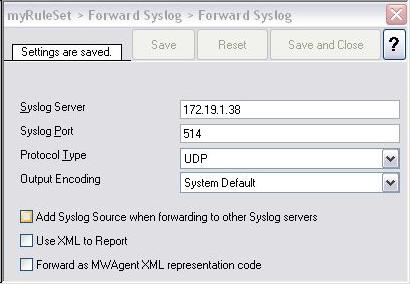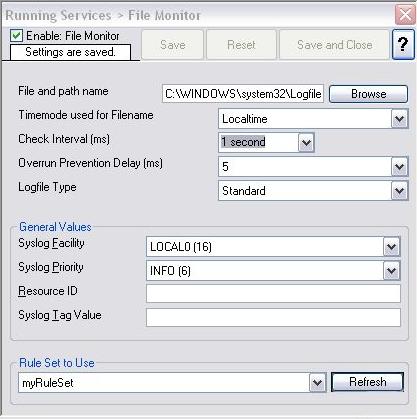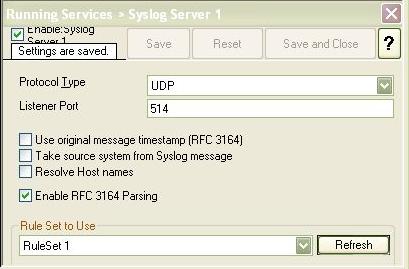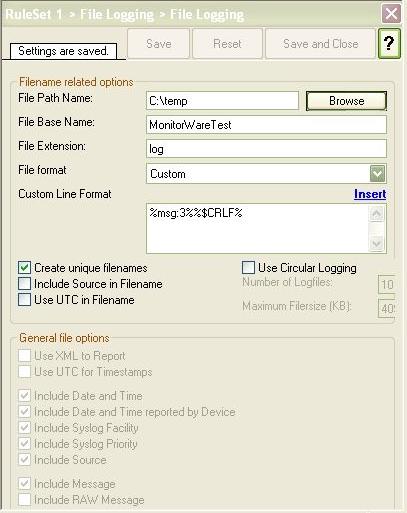How To setup PIX centralized Monitoring with MonitorWare Console 3.x
Article created 2005-05-17 by Hamid Ali Raja
Last Updated 2011-05-24 by Tom Bergfeld
Adiscon Products can be used to efficiently analyze PIX traffic as well. This article is strictly task focused. It does not describe why the systems should be monitored nor does it provide any further background. Please see the respective backgrounders or product documentation on this. This article is a step-by-step description of what you need to do in order to centrally monitor your PIX logs.
Centralized PIX Reports
In this step-by-step guide, WinSyslog is configured to work together with Adiscon’s MonitorWare Console to generate summaries for the traffic passing to and from PIX.
What you need
In this guide, I am focusing on building a solution with Adiscon’s WinSyslog and MonitorWare Console. This guide will be equally good for you if you want to configure MonitorWare Console with WinSyslog or to configure MonitorWare Console with MonitorWare Agent. The reason is that in this configuration a syslog server that will be listening for syslog messages is required. Since MonitorWare Agent and WinSyslog can act as syslog server, this guide can be used for both. The configuration steps are exactly the same in both cases.
This combination allows you to centralize all your logs and generate reports on them. Free 30 day trial versions are available at the respective product sites (links below), so you can try the system without the need to buy anything.
You need to run the following products:
- 1 WinSyslog for the system that will act as the syslog server.
- 1 MonitorWare Console to generate consolidated reports based on the gathered log data. This will also be installed on the same machine where you have installed WinSyslog.
- You need administrative privileges on each of the machines. This is required in both cases, for installation and configuration. Make sure you log on with a sufficiently privileged user account.
Step 1 – Download Software
You need to download the following software to follow this step by step guide:
1. www.winsyslog.com/en/download
2. www.mwconsole.com/en/downloadStep 2 – Install WinSyslog
Run the WinSyslog program on the system that is to act as the central server. Take a note of this server’s IP address or host name. You’ll need this value when configuring PIX to forward the messages to it.
Step 3 – Configure a Syslog Server
The steps to configure the WinSyslog as a syslog server are as follows:
Step 4 – Create a RuleSet for Database Logging
In this section, you will create an action to write the messages that are coming from PIX to a database. Please note that these steps would be exactly the same for both MonitorWare Agent and WinSyslog.
After configuring this RuleSet, make sure that
- this rule set is associated with the syslog server service that you created in step 3. You can do this by clicking on the syslog server service on the left hand side and by selecting the name of the rule set that you created in step 4 in “Rule Set to Use” combo box on the right hand side.
- The service is running. You can do this by clicking on the Play button at the top of the client.
Step 5 – Configure PIX
In this step, you will need to configure PIX in such a way so that it sends the messages to the syslog server that you created in the above step. You would need to give the IP address or the hostname in PIX.
Step 6 – Installing and Configuring MonitorWare Console
MWConsole- Installation and Configuration Steps
Step 7 – Generating PIX Reports with MonitorWare Console Manually
Following are the reports in MonitorWare Console that can be generated for PIX logs.
- Accessed Web Sites Report
- Blocked Ports Activity Report
- Possible Attacks Report
- PIX Summary By Message Type
- PIX Summary by Severity Level
- Traffic By Hour Report
- Traffic By Port Report
- Outbound Traffic By IP
- Traffic by Target IP
This section explains how the PIX reports can be generated with MonitorWare Console manually. In this section I will explain the generation of a specific report only. Please note that, the procedure for generating any report is almost the same.
Generating PIX Reports with Console 3.0 ManuallyStep 8 – Scheduling the Generation of Reports with MonitorWare Console
This section explains how the reports can be generated with MonitorWare Console automatically using Job Manager. With Job Manager, you can generate all the reports based on a pre-defined schedule and ask it to either store it in some location on the hard disk or send it to specified recipient via email. The following section explains the scheduling of System Status Report. You can use exactly the same method to generate any of the PIX reports that are mentioned above.
Scheduling Reports with Console 3.0
You are done!
Well, this is all you need to do to configure the basic operations. We hope this article is helpful. If you have any questions or remarks, please do not hesitate to contact us at support@adiscon.com



